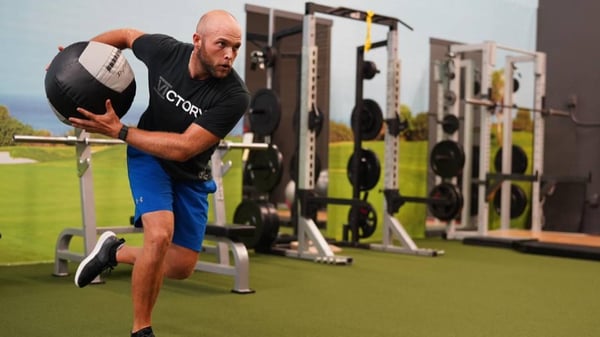
Have you ever had to fight through 18 holes with a sore shoulder? Are your feet killing you? It ain’t easy and it certainly takes away most of the fun! Like most athletes and outdoor enthusiasts, golfers are prone to some aches, pains and injuries, especially retirees who suddenly have plenty of time on their hands, yet may have spent the last 40 years sitting with poor posture at a desk.
Most golf injury articles focus on what to do when the damage is already done. While it’s great to provide solutions to problems, it’s always better to prevent these problems from happening in the first place. In this article, we’re going to focus on 10 simple steps you can take to keep your body healthy, help prevent common golf injuries and allow you to enjoy more time on the course.
Poor Swing Mechanics And A Stiff Body
Before discussing the 10 steps, we’re going to briefly talk about the primary reasons golfers get injured.
- Their body is too stiff. If you lack flexibility, then a golf swing will place a lot of strain on the wrong parts of your body. Instead of your body working in harmony to distribute the energy across your body, you might find your lower back or hips are taking most of the punishment (and they give up after a while).
- They go too hard at it. When you feel pain, it’s your body telling you something isn’t right. Maybe you’ve overdone it or an injury hasn’t fully healed itself. A common reason for injuries is simply playing too much golf when the body can’t handle it.
- They don’t strengthen the muscles, tendons and ligaments. To an outsider, golf may seem like an easy sport. In reality, the golf swing is an incredibly complex motion -- we’d argue THE most complex of all sports -- and it requires a strong body to perform correctly and injury-free.
Let’s break down the primary types of injuries.
Upper Body
- Elbows: Commonly known as golfer’s elbow.
- Wrist injuries: Due to a lack of strength and the amount of shock needed to be absorbed when club hits ball (or club accidentally hitting rock).
- Rotator cuff injuries: If your shoulders are stiff your muscles will take a violent blow each time you finish your swing.
Core/Back
-
Lower back: The sudden, violent movement of performing a golf swing places a tremendous amount of pressure on your lower back.
-
Pelvis: Proper Upper/Lower body separation (X-factor) in the golf swing means good pelvic rotation. If you don't have it, your body will make compensations that put you in more stressful positions.
- Tight Hamstrings: Surprising how tight leg muscles contribute to sore backs!
Lower Body
-
Knees: Being a joint, they will twist and turn with every swing. Damaged knees will struggle when explosive energy passes through them.
-
Ankles: Just like your knees, the twisting and turning can put a lot of pressure on your ankle joints.
-
Feet: While not much affected by the golf swing, all of that walking and standing around can be hard on your feet.
9 Steps to Preventing Golf Injuries
Before You Start
- Strive to be flexible. We might sound like a broken record, but flexibility is your number one friend in golf. Do stretching exercises regularly, before and after playing.
- Strengthen your muscles. We’re not talking about bulking up. Focus on doing the right strength training exercises and avoid the wrong exercises which can stiffen your muscles.
- Build up your endurance. Five hours of walking during a day on the course is not for the faint of heart. If you haven’t done much exercise recently, start by taking a few strolls around your neighborhood. Then try jogging, bicycling or swimming.
- Maintain proper posture. Stand with your feet shoulder-width apart and slightly rotated outward, with your knees slightly bent. Hold your spine relatively straight. Your trunk should be tilted forward, but most of that movement should come from your hips. Avoid hunching over the ball, which can lead to neck and back strain.
- Beware of the overswing. Until you’re comfortable in your swing, be patient. Don’t overswing and hurt your lower back by putting too much stress on your joints. Relax and take a nice, easy swing at the golf ball.
- Select the right shoes. Don’t show up in your old disco shoes (we know you still got them). If you can, wear specifically designed golf shoes with short cleats. Long cleats dig into the sod and hold your feet planted as you swing, which may place more strain on your knees.
On the Course
- Warm up before tee time. Many of us have been guilty of hopping into our car, driving to the golf course, and teeing up right away. No stretching, no warm up, nothing. The good news is, you don’t need a whole lot of time to warm up. Even just a few stretches in the parking lot will make a big difference.
- Start slowly. After not hitting a single golf ball in months, have you ever jumped straight into a round of 18 holes? Unless you’re a professional golfer (or you train a lot during the off season), your body might not be able to handle the strain. Start off slowly. Hit a few balls on the range first.
- Keep your golf swing technique smooth and consistent. If your swing mechanics are off, you risk placing too much strain on just a few muscles. They might not be able to handle that pressure for too long. Get a good swing coach to look at your swing and make sure you're getting into the right positions for your body and club head speed.
Coming Back from Common Golf Injuries
-
Before doing anything else, talk to your doctor! Whether you go to a family doctor or a specialist, they can recommend which treatment option will have the best chance of success. If you’re suffering from severe muscular pain, or your joints and tendons feel like they are on fire, get a professional medical opinion.
-
Start by slowly stretching your body. Take a quick 15 minute walk to get your body warm and some blood flowing ahead of time. If you’re not sure what type of stretches to perform, there's a good one at the beginning of Coach Joey D's free workout over at Hit IT Great ON DEMAND.
-
While stretching is great, you also need to build some functional strength in your muscles and joints. Just be careful not to perform dangerous exercises that won’t help improve your golf game. Pick programs that are golf-specific.
-
Ice Ice Baby! If your joints are swollen and muscles are wore, put some ice on them and take is easy. Rest and recovery are largely underrated by recreational golfers, but so essential to consistent good play.
We want to avoid injury and play more golf. We call it 'pre-hab.'
Injury prevention should not be something you ignore. To enjoy a better golf game, make sure your body can handle the range of motion involved. If you’re stiff, stretch. If your muscles are weak, strengthen them. If you’re in a lot of pain, see a doctor. Whatever you do, don’t do nothing!
If you'd like some help, we're here for you no matter where you live. We've got great training options for players at all levels.
Team Joey D Golf
© 2020 joeydgolf.com


